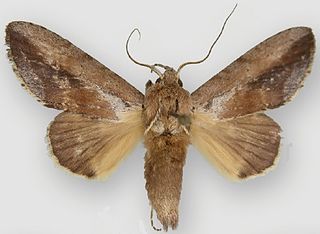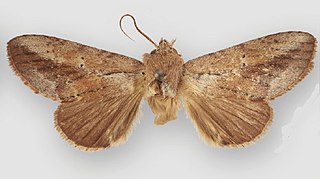Xenorma ravida is a moth of the family Notodontidae. It is found in western Ecuador.
Phanoptis donahuei is a moth of the family Notodontidae. It is found in southern Mexico.
Argentala argoptera is a moth of the family Notodontidae first described by James S. Miller in 2008. It is found along the western slope of the Ecuadorian Andes in cloud forest habitats at elevations between 1,200 and 2,600 meters.
Argentala brehmi is a moth of the family Notodontidae first described by James S. Miller in 2008. It is endemic to the eastern slope of the Andes.
Polypoetes leuschneri is a moth of the family Notodontidae first described by James S. Miller in 2008. It is endemic to the Pacific slope of the Ecuadorian Andes.
Hadesina goeleti is a moth of the family Notodontidae first described by James S. Miller in 2008. It is found in north-western Costa Rica, near the Nicaraguan border.
Brachyglene fracta is a moth of the family Notodontidae first described by James S. Miller in 2008. It is endemic to north-central Venezuela.
Nebulosa yanayacu is a moth of the family Notodontidae first described by James S. Miller in 2008. It is found along the eastern slope of the Ecuadorian Andes.
Scoturopsis franclemonti is a moth of the family Notodontidae. It is found in the eastern Andes of southern Peru.
Xenomigia pinasi is a moth of the family Notodontidae. It is found along the eastern slope of the Ecuadorian Andes.
Xenomigia involuta is a moth of the family Notodontidae. It is endemic to cloud forests on the western slope of the Ecuadorian Andes.
Pareuchontha olibra is a moth of the family Notodontidae. It is found along eastern slope of the Ecuadorian Andes.
Pareuchontha fuscivena is a moth of the family Notodontidae first described by James S. Miller in 2008. It is found in the western foothills of the Andes in Colombia.
Tithraustes snyderi is a moth of the family Notodontidae. It is found in cloud-forest habitats within La Amistad, an international park extending from south-central Costa Rica into the Chiriqui Province of Panama.

Disphragis notabilis is a moth of the family Notodontidae first described by William Schaus in 1906. It is found throughout the Amazon basin from western Venezuela east- and southward to at least Bolivia. The range includes French Guiana.
Xenomigia caesura is a moth of the family Notodontidae. It is found in north-eastern Ecuador.
Xenomigia flavivulta is a moth of the family Notodontidae. It is found in north-eastern Ecuador.
Xenomigia noctipenna is a moth of the family Notodontidae. It is found in north-eastern Ecuador.

Disphragis bifurcata is a moth in the family Notodontidae first described by J. Bolling Sullivan and Michael G. Pogue in 2014. It is found from Guatemala to Colombia, probably extending south into northern Ecuador. It is found at lower altitudes and moderate elevations up to about 1,000 meters.

Disphragis hemicera is a moth in the family Notodontidae first described by William Schaus in 1910. It is found throughout Costa Rica at moderate altitudes. It is found south along the western coast of Colombia and may extend to the west coast of Ecuador. The northern limits are unknown but it probably occurs at least into Nicaragua.


